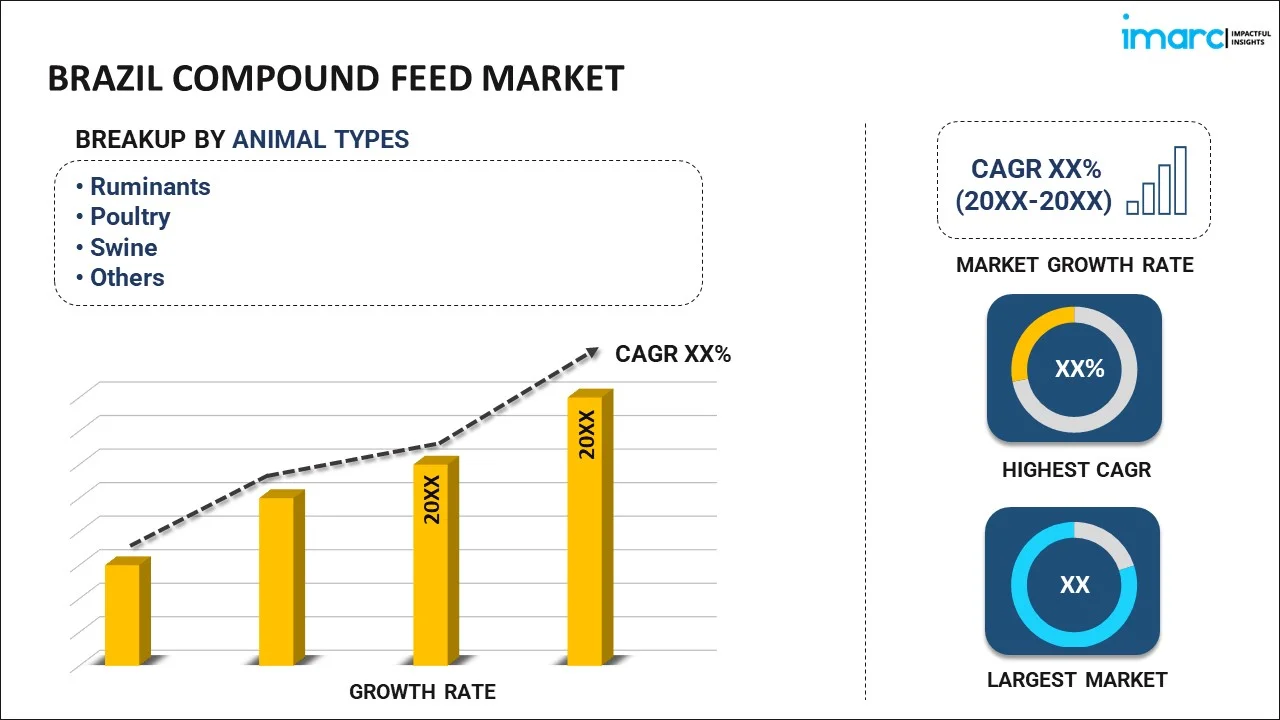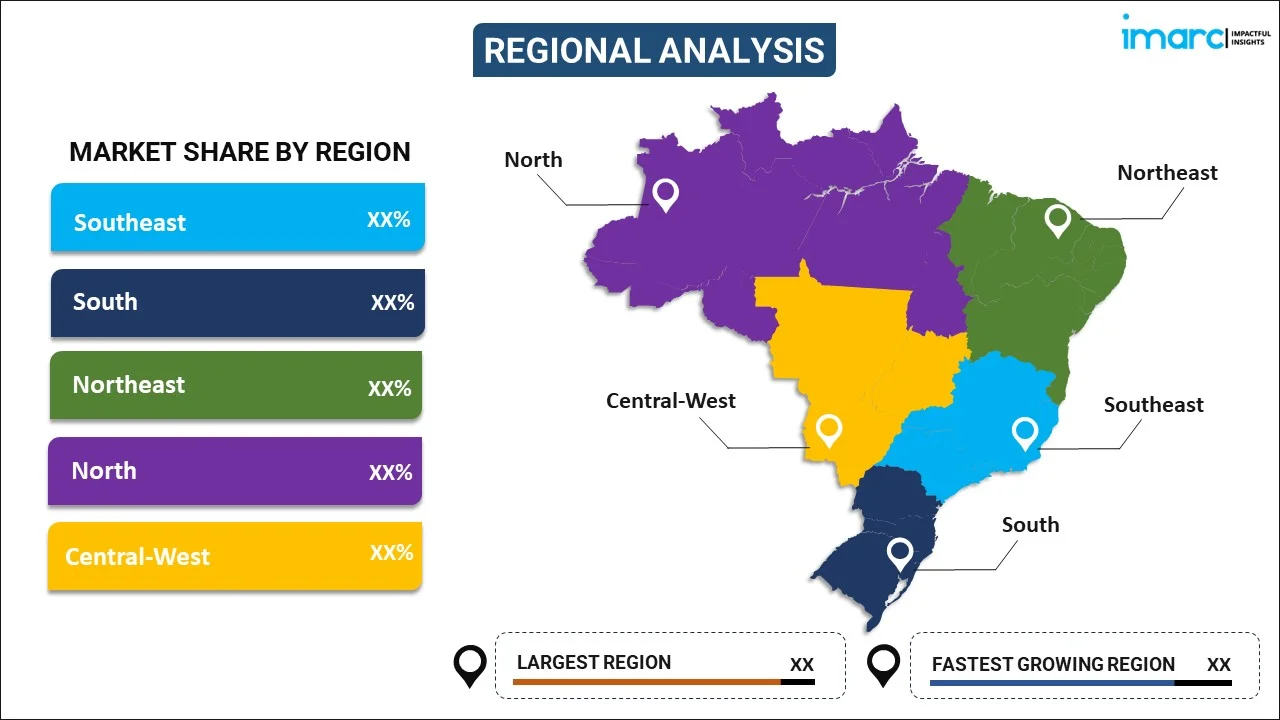
Brazil Compound Feed Market Report by Animal Type (Ruminants, Poultry, Swine, Aquaculture, and Others), Ingredient (Cereals, Cakes and Meals, By-products, Supplements), and Region 2024-2032
Market Overview:
Brazil compound feed market size is projected to exhibit a growth rate (CAGR) of 4.73% during 2024-2032. The availability of vast expanses of arable land and a favorable climate for agriculture, increasing population of the country, and the rising adoption of digital technologies in agriculture and livestock management represent some of the key factors driving the market.
|
Report Attribute
|
Key Statistics
|
|---|---|
|
Base Year
|
2023 |
|
Forecast Years
|
2024-2032
|
|
Historical Years
|
2018-2023
|
| Market Growth Rate (2024-2032) | 4.73% |
Compound feed, also known as pelleted or manufactured feed, is a carefully formulated mixture of various ingredients. It is prepared using cereals, such as corn, wheat, and barley, along with protein sources like soybean meal, fish meal, and other oilseed meals. It is packed with protein and essential nutrients and ensures a balanced diet. It is also fortified with vitamins and minerals and offers specific dietary requirements. It helps meet the nutritional requirements of livestock, poultry, and some aquatic species. It promotes optimal growth, reproduction, and overall health of animals. Its composition can vary significantly depending on the target species, animal age, and purpose. It also simplifies the feeding process, reducing the need for complex and time-consuming nutritional calculations. Furthermore, it contributes to increased efficiency in livestock and poultry production and helps meet the growing demand for animal products worldwide. Besides this, as it reduces greenhouse gas emissions associated with animal agriculture, the demand for compound feed is rising across Brazil.
Brazil Compound Feed Market Trends:
The availability of vast expanses of arable land and a favorable climate for agriculture in Brazil make it a key player in livestock production. Additionally, the growing population of the country is driving the demand for animal protein, which, in turn, is increasing the need for compound feed. Additionally, the evolution of the livestock sector in Brazil, coupled with a shift towards more intensive and technologically advanced farming practices, is offering a favorable market outlook. This intensification requires high-quality compound feed to ensure the health and productivity of livestock, further facilitating the market growth. Apart from this, the growing environmental concerns, particularly related to deforestation and land use, are driving the demand for more responsible agricultural practices. As a result, feed manufacturers are increasingly incorporating sustainable ingredients and production methods to reduce deforestation rates. Furthermore, the globalization of the Brazilian meat industry is catalyzing the demand for standardized and high-quality compound feed formulations. This trend enhances export opportunities and fosters innovation in the local feed industry. Moreover, governing agencies of the country are actively promoting and supporting the agriculture and livestock sectors through various policies and incentives. These policies encourage investments in the industry, creating a conducive environment for feed manufacturers and livestock producers. Moreover, these agencies are emphasizing biosecurity and disease control measures, which is catalyzing the demand for high-quality feed that supports animal health, ensuring the safety and quality of animal products. Besides this, the rising adoption of digital technologies in agriculture and livestock management is favoring the market growth.
Brazil Compound Feed Market Segmentation:
IMARC Group provides an analysis of the key trends in each segment of the market, along with forecasts at the country level for 2024-2032. Our report has categorized the market based on animal type and ingredient.
Animal Type Insights:

- Ruminants
- Poultry
- Swine
- Aquaculture
- Others
The report has provided a detailed breakup and analysis of the market based on the animal type. This includes ruminants, poultry, swine, aquaculture, and others.
Ingredient Insights:
- Cereals
- Cakes and Meals
- By-products
- Supplements
A detailed breakup and analysis of the market based on the ingredient have also been provided in the report. This includes cereals, cakes and meals, by-products, and supplements.
Regional Insights:

- Southeast
- South
- Northeast
- North
- Central-West
The report has also provided a comprehensive analysis of all the major regional markets, which include Southeast, South, Northeast, North, and Central-West.
Competitive Landscape:
The market research report has also provided a comprehensive analysis of the competitive landscape in the market. Competitive analysis such as market structure, key player positioning, top winning strategies, competitive dashboard, and company evaluation quadrant has been covered in the report. Also, detailed profiles of all major companies have been provided.
Brazil Compound Feed Market Report Coverage:
| Report Features | Details |
|---|---|
| Base Year of the Analysis | 2023 |
| Historical Period | 2018-2023 |
| Forecast Period | 2024-2032 |
| Units | US$ Million |
| Scope of the Report | Exploration of Historical and Forecast Trends, Industry Catalysts and Challenges, Segment-Wise Historical and Predictive Market Assessment:
|
| Animal Types Covered | Ruminants, Poultry, Swine, Aquaculture, Others |
| Ingredients Covered | Cereals, Cakes and Meals, By-products, Supplements |
| Regions Covered | Southeast, South, Northeast, North, Central-West |
| Customization Scope | 10% Free Customization |
| Report Price and Purchase Option | Single User License: US$ 3699 Five User License: US$ 4699 Corporate License: US$ 5699 |
| Post-Sale Analyst Support | 10-12 Weeks |
| Delivery Format | PDF and Excel through Email (We can also provide the editable version of the report in PPT/Word format on special request) |
Key Questions Answered in This Report:
- How has the Brazil compound feed market performed so far and how will it perform in the coming years?
- What has been the impact of COVID-19 on the Brazil compound feed market?
- What is the breakup of the Brazil compound feed market on the basis of animal type?
- What is the breakup of the Brazil compound feed market on the basis of Ingredient?
- What are the various stages in the value chain of the Brazil compound feed market?
- What are the key driving factors and challenges in the Brazil compound feed?
- What is the structure of the Brazil compound feed market and who are the key players?
- What is the degree of competition in the Brazil compound feed market?
Key Benefits for Stakeholders:
- IMARC’s industry report offers a comprehensive quantitative analysis of various market segments, historical and current market trends, market forecasts, and dynamics of the Brazil compound feed market from 2018-2032.
- The research report provides the latest information on the market drivers, challenges, and opportunities in the Brazil compound feed market.
- Porter's five forces analysis assist stakeholders in assessing the impact of new entrants, competitive rivalry, supplier power, buyer power, and the threat of substitution. It helps stakeholders to analyze the level of competition within the Brazil compound feed industry and its attractiveness.
- Competitive landscape allows stakeholders to understand their competitive environment and provides an insight into the current positions of key players in the market.
Need more help?
- Speak to our experienced analysts for insights on the current market scenarios.
- Include additional segments and countries to customize the report as per your requirement.
- Gain an unparalleled competitive advantage in your domain by understanding how to utilize the report and positively impacting your operations and revenue.
- For further assistance, please connect with our analysts.
 Inquire Before Buying
Inquire Before Buying
 Speak to an Analyst
Speak to an Analyst
 Request Brochure
Request Brochure
 Request Customization
Request Customization




.webp)




.webp)












